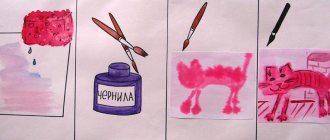“Pedagogical technologies in the cognitive development of preschool children” article
"Pedagogical technologies
in the cognitive development of preschool children"
Relevance:
The problem of developing the cognitive activity of preschool children is one of the most pressing.
Curiosity, a constant desire to observe and experiment, to seek new information about the world around us are the most important features of children's behavior. A child is born an explorer - this is his natural state. The internal desire to explore gives rise to the child’s exploratory behavior and creates the conditions for the child’s mental development to unfold as a process of self-development.
Our task, the task of teachers, is not to suppress the research and cognitive activity of children, but, on the contrary, to help its development.
The use of modern pedagogical technologies opens up new opportunities for the education and training of preschoolers, and one of the most effective, in my opinion, is -
1. Technology of children's experimentation.
It is more natural and therefore much easier for a child to comprehend new things by conducting his own research - observations, experiments, making his own judgments and conclusions based on them, than to receive knowledge obtained by someone in a ready-made form.
The child strives for independence, but he cannot understand the world without the help of an adult. At any age, the role of the teacher remains leading. Without an adult, experiments turn into aimless manipulation of objects, without conclusions and without cognitive value.
In the group room of the senior group, a center for children's experimentation called “Our Laboratory” was created, which contains natural materials: sand, water, clay, pebbles, shells, various seeds and fruits, tree bark, leaves, etc. As well as sieves and funnels of different sizes and materials, pipettes with rounded ends, plastic syringes without needles, waste material (paper of different color textures, pieces of leather, foam rubber, rubber, plastic, metal objects, cork, wire, etc.), hourglass, mechanical, etc. This form of work ensures personality-oriented interaction between an adult and a child (together, on equal terms, as partners), while creating a special atmosphere that will allow each child to realize their inquisitive and cognitive activity - information and communication technologies
Modern educational technologies include:
2. Technology of project activities
Goal: Development and enrichment of social and personal experience through the inclusion of children in the sphere of interpersonal interaction.
Teachers who actively use project technology in the upbringing and teaching of preschoolers unanimously note that life activities organized according to it in kindergarten allow them to get to know the students better and penetrate into the child’s inner world.
To ensure the cognitive activity of children in our group, the project method is widely used. It allows children to develop their cognitive abilities, teaches them to navigate the information space, and develop logical thinking. In our senior group, educational and research projects “Soap Story” and “Magnetic Miracles” were developed.
In the educational process of a preschool educational institution, project activities are in the nature of cooperation, in which children and teachers of the preschool educational institution take part, and parents and other family members are also involved. Parents can not only be sources of information, real help and support for the child and teacher in the process of working on the project, but also become direct participants in the educational process, enrich their teaching experience, experience a sense of ownership and satisfaction from their successes and the successes of the child. The main goal of the project method in a preschool institution is the development of a free creative personality, which is determined by the developmental tasks and tasks of children's research activities. The tasks of research activities are specific for each age. So, when working with children of primary preschool age, can a teacher use hints and leading questions? And children of older preschool age need to be given more independence
3. Research technology. The goal of research activities in kindergarten is to form in preschoolers the basic key competencies and the ability for a research type of thinking.
Collecting is one of the forms of cognitive activity of a preschooler, which is based on collecting something that has a certain value for the child. Collecting supports children's individual cognitive preferences. Our group has a collection of stones, a collection of seashells, magnets, and herbariums. To ensure the cognitive activity of children in our kindergarten, the project method is widely used. It allows children to develop their cognitive abilities, teaches them to navigate the information space, and develop logical thinking.
4. TRIZ technology
TRIZ (the theory of inventive problem solving).
The teacher uses non-traditional forms of work that put the child in the position of a thinking person. TRIZ technology adapted for preschool age will allow you to educate and train a child under the motto “Creativity in everything!” Preschool age is unique, because as a child is formed, so will his life, which is why it is important not to miss this period to reveal the creative potential of each child.
The purpose of using this technology in kindergarten is to develop, on the one hand, such qualities of thinking as flexibility, mobility, consistency, and on the other hand, search activity, the desire for novelty; speech and creative imagination.
The main goal of using TRIZ technology in preschool age is to instill in the child the joy of creative discovery.
5. Information and communication technologies
The world in which a modern child develops is fundamentally different from the world in which his parents grew up. This places qualitatively new demands on preschool education as the first link of lifelong education: education using modern information technologies (computer, multimedia equipment, tablet, laptop, etc.).
Computer advantages:
presenting information on a computer screen in a playful way arouses great interest among children;
carries a figurative type of information that is understandable to preschoolers;
movements, sound, animation attract the child’s attention for a long time;
has a stimulus for children's cognitive activity;
provides the opportunity to individualize training;
in the process of working at the computer, the preschooler gains self-confidence;
allows you to simulate life situations that cannot be seen in everyday life.
ICT in the work of a modern teacher:
Selection of illustrative material for classes and for the design of stands, groups, classrooms (scanning, Internet, printer, presentation).
Selection of additional educational material for classes, familiarization with scenarios for holidays and other events.
Exchange of experience, acquaintance with periodicals, the developments of other teachers in Russia and abroad.
Preparation of group documentation and reports. The computer will allow you not to write reports and analyzes every time, but rather just type the diagram once and then only make the necessary changes.
Creating presentations in the Power Point program to improve the effectiveness of educational activities with children and the pedagogical competence of parents during parent-teacher meetings.
6. Personally-oriented technology
Personality-oriented technology is implemented in a developmental environment that meets the requirements of the content of new educational programs. Creating conditions for personality-oriented interactions with children in a developmental space that allows the child to show his own activity and realize himself most fully.
7. Gaming technology
It is built as a holistic education, covering a certain part of the educational process and united by common content, plot, and character.
Learning in the form of a game can and should be interesting, entertaining, but not entertaining. To implement this approach, it is necessary that educational technologies developed for teaching preschoolers contain a clearly defined and step-by-step described system of gaming tasks and various games so that, using this system, the teacher can be confident that as a result he will receive a guaranteed level of learning a child of one or another subject content.
Gaming technologies are closely related to all aspects of the educational work of a kindergarten and the solution of its main tasks. Some modern educational programs propose using folk games as a means of pedagogical correction of children's behavior.
8. Integrated lesson technology
An integrated lesson differs from a traditional lesson in the use of interdisciplinary connections, which provide only occasional inclusion of material from other subjects.
Integration - combine knowledge from different educational fields on an equal basis, complementing each other. At the same time, several development problems are solved. In the form of integrated classes, it is better to conduct general classes, presentations of topics, and final classes.
Every teacher is a creator of technology, even if he deals with borrowings. The creation of technology is impossible without creativity.
Analyzing all of the above, we can conclude that specially organized research activities allow our students to obtain information about the objects being studied themselves, and the teacher to make the learning process effective and more fully satisfy the curiosity of preschoolers, developing their cognitive activity.
The program is based on the following main lines of development of a preschooler:
1) formation of voluntary behavior;
2) mastery of the means and standards of cognitive activity;
3) transition from egocentrism to decentration (the ability to see the world from the point of view of another person),
4) motivational readiness.
These four lines of development determine the content and didactics of preschool education. When developing the proposed program, the accumulated positive experience of modern preschool education was taken into account, as well as new approaches in this area. The program does not claim to be universal. However, it will, firstly, help overcome the negative trend of a simplified understanding of the content of education during preschool childhood and the use of forms that are not specific to it. Therefore, gaming educational technologies are leading in all sections of the educational and cognitive block of the program, and the knowledge offered to children acts as a means of developing the personality of a preschool child. Secondly, it will ensure the continuous and progressive development of the child’s personality at all subsequent stages of education under the conditions of a unified educational system. A comprehensive program for the development and education of preschool children is implemented in specific manuals recommended by the Ministry of Education and Science of the Russian Federation, and methodological recommendations for teachers (see the list of references at the end).
Continuation of continuous courses on all educational lines in primary school is provided by programs and textbooks of the same authors.
Structure and content of the program
The program is presented in the following sections: 1. Age characteristics of children. 2. Organization of life. Protection and promotion of health of preschool children. 3. Physical development. 4. Play activities. 5. Social and personal development. 6. Cognitive activity: • Development of speech and preparation for learning to read and write. • Familiarization with the surrounding world and environmental education • Introduction to mathematics. • Visual activities. 7. Education and development of personal qualities. Each section of the program maintains the general tendency of continuity in the development and upbringing of children, continuity of education, ensuring the child’s successful advancement at each of the successive age stages of his development. The success of the development and upbringing of a preschooler depends on how physically prepared the child is for it. “Physical Development” is important in the program
Health is considered in the program not only as a physical state and well-being, but much more broadly - both from the point of view of awareness of one’s physicality as a way of contact with the world and as a person’s emotional, social, mental and psychological well-being.
7 pages, 3497 words
Work program of the discipline Management Psychology
... characteristics of managers and factors influencing the effectiveness of management activities. Structure and content of the discipline of management psychology. Module title... using modern diagnostic methods to identify comprehensive aspects of management activities, they will acquire the skills to assess the personal characteristics of managers that influence... This program complies with the federal state...
The purpose of physical education classes is to familiarize the child with the basics of a healthy lifestyle, to master a hygienic culture and a culture of movement. The physical development of a preschooler primarily involves the formation of interest in active motor activity and the need for physical self-improvement, enjoying games, movements, and exercises. In the "Game activity"
describes a variety of games (creative, didactic, active, etc.) that ensure the full development of a preschooler.
In play activities, the child actively cooperates with adults and peers, thus enriching his own life experience. Intelligently organized communication plays an important role. The teacher encourages the child to dialogue, directs his efforts to create an atmosphere of trust and mutual understanding; promotes self-expression of the emotional and sensory sphere of preschool children. When a child goes to school, play retains its value as a way of appropriating social experience, communicating with peers, and developing arbitrary behavior. It is no coincidence that the game as a teaching method is given preference in the section “Educational and cognitive activity”
.
Social and personal development
involves the development of a preschooler’s natural curiosity, including interest in himself, in the perception of himself by peers and adults, support in finding his place in the system of social relations and the world around him, and mastering basic social skills, including labor skills.
This section is considered as psychological and pedagogical support for the process of a child’s entry into the world of knowledge and social relations. The section “Cognitive activity”
consists of a number of areas, each of which, while maintaining its independent role in the content of education, is inextricably linked with all the others, consistently implementing the previously identified lines of development of preschoolers.
The teacher instills in children basic learning skills: listen to an adult’s explanations, complete a task without interfering with each other, and show activity and interest in the proposed activity. The teacher supports the children’s efforts to complete the task efficiently with praise and positive evaluation; encourages children's statements and judgments, promotes the development of positive self-esteem in children. The implementation of the principle of continuity, which we declared as the main distinctive feature of the program, is manifested in the fact that in addition to subject content, all programs that provide cognitive activity for preschoolers are focused on the development of not only subject-specific, but also general academic skills. Further development of this group of skills is carried out in primary school through all academic subjects.
2 pages, 741 words
A modern view on the problem of DEVELOPMENT OF THE SUBJECTIVE POSITION of a preschooler
...text follows. Sample format for the text of an article: a modern view of the problem of DEVELOPMENT OF THE SUBJECTIVE POSITION OF A PRESCHOOL CHILDREN I.I. Ivanova Federal State Budgetary Educational Institution of Higher Education “Tolyatti State University”, Russia Beginning...


